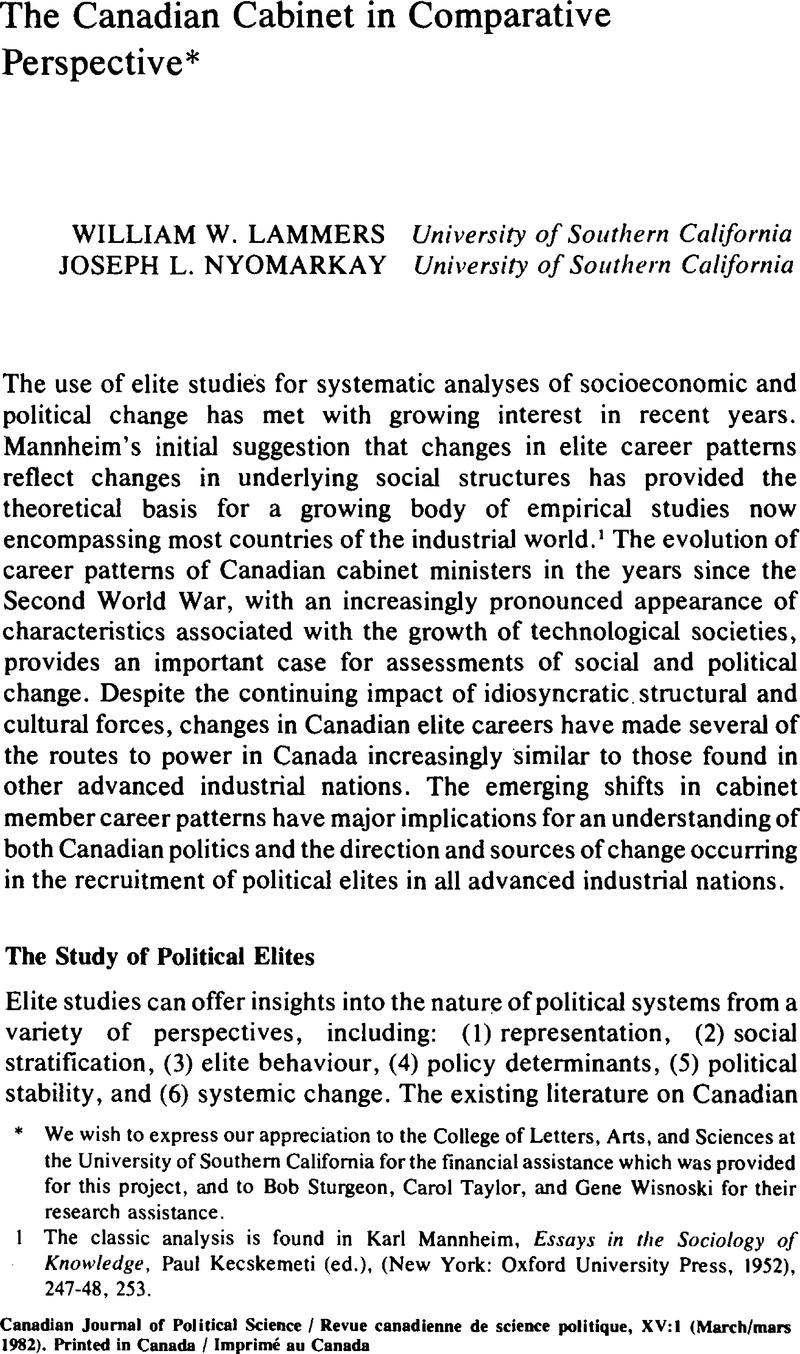No CrossRef data available.
Article contents
The Canadian Cabinet in Comparative Perspective*
Published online by Cambridge University Press: 10 November 2009
Abstract

- Type
- Research Article
- Information
- Canadian Journal of Political Science/Revue canadienne de science politique , Volume 15 , Issue 1 , March 1982 , pp. 29 - 46
- Copyright
- Copyright © Canadian Political Science Association (l' Association canadienne de science politique) and/et la Société québécoise de science politique 1982
References
1 The classic analysis is found in Karl Mannheim, Essays in the Sociology of Knowledge, Paul, Kecskemeti (ed.), (New York: Oxford University Press, 1952), 247–48, 253.Google Scholar
2 The early work on representation is contained in Norman Ward, The Canadian House of Commons: Representation (Toronto: University of Toronto Press, 1950).Google ScholarThe more recent studies include W. A. Matheson, The Prime Minister and the Cabinet (Toronto: Methuen, 1976)Google ScholarPubMed, and Loon, Richard Van, “The Structure and Membership of the Canadian Cabinet” (Ottawa: Royal Commission on Bilingualism and Biculturalism, 1965)Google Scholar.
3 Matheson, The Prime Minister and the Cabinet, 29–30.
4 See John, Porter, The Vertical Mosaic (Toronto: University of Toronto Press, 1965)Google Scholar.
5 See Campbell, Colin and Szablowski, George, The Superbureaucrafts: Structure and Behaviour in Central Agencies (Toronto: Macmillan, 1979)Google Scholar.
6 See Robert V., Presthus, Elite Accommodation in Canadian Politics (Toronto: Cambridge University Press, 1973)Google Scholar.
7 See Kornberg, Allan, Falcone, David J., and Mishler, William T. E., Legislatures and Societal Change: The Case of Canada (Beverly Hills: Sage, 1973)Google Scholar.
8 The major initial work is Arend Lijphart, The Politics of Accommodation: Pluralism and Democracy in the Netherlands (Berkeley: University of California Press, 1968)Google Scholar. Canadian applications are discussed in Presthus, Elite Accommodation, and McRae, K. D. (ed.), Consociational Democracy: Political Accommodation in Segmented Societies (Toronto: McClelland and Stewart, 1974)Google Scholar.
9 Two recent books have extensively developed the systemic approach. See Robert, D. Putnam, The Comparative Study of Political Elites (Englewood Cliffs: Prentice-Hall, 1976), 165–214;Google Scholar and Welsh, William W., Leaders and Elites (New York: Holt, Rinehart and Winston, 1959), 58–96Google Scholar.
10 See Henry, S. Albinski, Canadian and Australian Politics in Comparative Perspective (New York: Oxford University Press, 1973), 289–304Google Scholar.
11 The initial study of Canada by Campbell and Szablowski, The Superbureaucrats, is being expanded to include the United Kingdom, the United States, and Switzerland.
12 See Robert, V. Presthus, Elites in the Policy Process (New York: Cambridge University Press, 1974)Google Scholar.
13 Biographical information was gathered from at least two or three sources in each country. For France, the most extensive information for each individual is in Jean, Jolly (ed.), Dictionnaire des parlementaires français, 1889–1940 (Paris: Presses universitaires de France, 1960)Google Scholar. For the United Kingdom, the standard initial source is Dod's Parliamentary Companion (London: Business Dictionaries). The most extensive United States information is in Robert, Sobel (ed.), Biographical Directory of the United States Executive Branch (Westport, Conn.: GreenwoodGoogle Scholar, 1972). Canadian sources included The Canadian Who's Who (Toronto: Who's Who Canadian Publication)Google Scholar, The Dictionary of Canadian Biography (Toronto: Macmillan, 1926Google ScholarPubMed), and Johnson, J. K. (ed.), Canadian Directory of Parliament 1867–1967 (Ottawa: Public Archives of Canada, 1968Google Scholar).
14 The basic career data have been studied with the use of several different time periods in previous papers. The differences are minor in all instances. For Canada, the periods conform to those used by Matheson with the exception of the division of the post-Second World War period. The findings in previous analyses which have used the backgrounds of all individuals who have served in a given period are generally quite similar to those which have emerged in this analysis. We are nonetheless persuaded by such works as Phillip Buck in his Amateurs and Professionals in British Politics, 1918–1959 (Chicago: University of Chicago Press, 1963) that an examination of newcomers represents the theoretically most justifiable approach.
15 The best known interpretation of the growth of technological societies is Jacques Ellul, The Technological Society (New York: Knopf, 1967)Google ScholarPubMed.
16 The Canadian figures in the category of law as one's major occupational activity have also been quite constant for the House of Commons, but at a lower level than for the Cabinet. Between 1967 and 1945, the percentage of lawyers in the Commons was generally between 20 and 30. These data are presented in Norman Ward, The Canadian House of Commons: Representation (Toronto: University of Toronto Press, 1950)Google Scholar.
17 Porter, The Vertical Mosaic, 209, 369.
18 We wish to express our sincere appreciation to Edward M. Hepner, the Canadian Consul in Los Angeles, for his assistance in making a set of extensive recent biographical summaries available for this project.
19 A basic introduction to the literature on this topic is provided in Thomas Hockin, A., Apex of Power; The Prime Minister and Political Leadership in Canada (2nd ed.: Scarborough: Prentice-Hall, 1977)Google Scholar.




